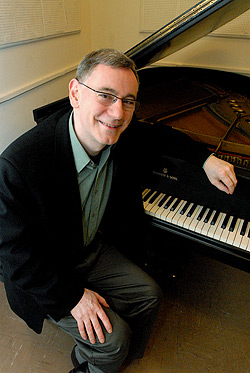By Stephen Brookes • The Washington Post • August 13, 2012
Things are heating up in the bare-knuckle world of competitive harpsichord playing this week as the Westfield International Harpsichord Competition gets underway at the University of Maryland. Twenty-five young players from around the world are duking it out in a savage bid for glory, and the finals (scheduled for Saturday, and open to the public) won’t be pretty. Although, to tell the truth, they probably will be kind of pretty — and even ravishing — if the performance on Sunday night by the British harpsichordist Davitt Moroney is any indication. Moroney is one of the most accomplished players in the world, marrying deep scholarship with a lively musical imagination, and he presented a program of 17th- and early 18th-century music at the Hall of Musical Instruments of the National Museum of American History that showcased the harpsichord’s subtle, elusive and often overlooked eloquence.
Although, to tell the truth, they probably will be kind of pretty — and even ravishing — if the performance on Sunday night by the British harpsichordist Davitt Moroney is any indication. Moroney is one of the most accomplished players in the world, marrying deep scholarship with a lively musical imagination, and he presented a program of 17th- and early 18th-century music at the Hall of Musical Instruments of the National Museum of American History that showcased the harpsichord’s subtle, elusive and often overlooked eloquence.
Playing on four of the museum’s antique and highly individual instruments, Moroney treated the harpsichords as full partners. “We have to listen to them, and work out how they want to be played,” he said as he stood (or rather, stooped) at a tiny 1620 virginal to draw out the gossamer beauty of Henry Purcell’s Suite in D Major, then switched to a 1694 harpsichord by Nicolaus DeQuoco to achieve the richer, bigger sound needed for Louis Couperin’s Pieces in E Minor and three complex dances by William Byrd.
Francois Couperin’s Eight Preludes required a more robust harpsichord from 1745, and the evening closed with the colorful Suite in D Minor by Louis Marchand (a composer usually remembered for bowing out of a harpsichord duel with Johann Sebastian Bach), played on a 1760 instrument by Benoist Stehlin.
Moroney’s playing was superb throughout; this is introspective music that comes alive not through raw power or burning passion, but from the quieter depths of understanding, and Moroney showed himself to be a poet of the meditative, thoughtful phrase. The intriguing evening ended on a touching note as Moroney, after taking a quick bow, gestured affectionately at the harpsichord — inviting the audience to applaud it, as well.